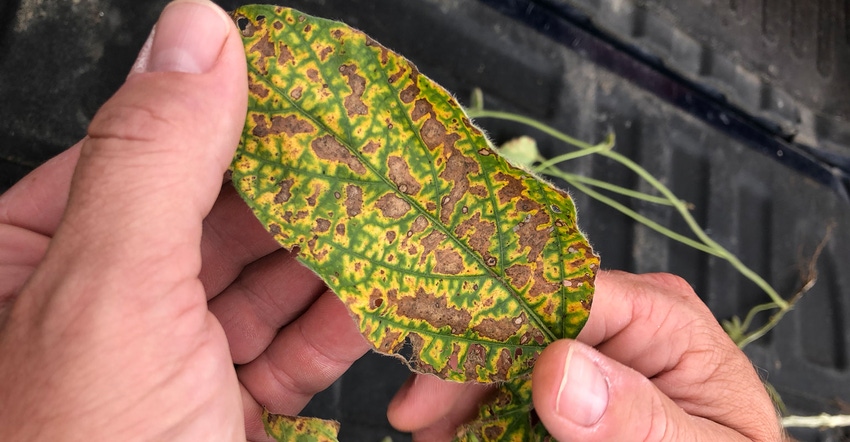
When Steve Gauck visited the Soybean Watch ’18 field in mid-August, he noticed signs of sudden death syndrome. However, the disease primarily appeared in scattered spots — sometimes just a plant or two in a sea of otherwise healthy plants full of pods.
“The disease definitely made an appearance this year,” says Gauck, a Beck’s sales agronomist based near Greensburg, Ind. Beck’s sponsors the Soybean Watch ’18 program. The goal of the program is to observe what’s happening in one field from planting through harvest, and relate things that may have appeared in your fields this year.
“We’ve had several reports of SDS in our area, and we’ve seen quite a bit of it,” Gauck says. “It can impact yields hard if large areas of the field are affected and it shuts down plants early.”
Identify SDS
Your first task is to positively identify the disease, Gauck notes. SDS can show up soon after R2, which is the reproductive stage with flowers open at uppermost nodes. It wasn’t apparent in the Soybean Watch ’18 field until pods formed.
According to the Purdue University Corn and Soybean Field Guide, which Gauck carries with him when he scouts fields, SDS starts with interveinal leaf chlorosis. Translated, that means green leaves begin to yellow between veins. Necrosis follows, meaning leaf tissue turns brown and dies.
“The key to knowing if it’s SDS is to pull a plant and split the lower stem open,” Gauck says. “Brown rot turns the pith a brownish color. With SDS, the pith remains white.”
SDS infection actually occurs earlier in the season, during vegetative stages, Gauck explains. The soilborne fungus survives in infected residue. Cool, wet weather while soybeans are growing and wet conditions at flowering followed by dry conditions later tend to favor the disease. It was hot and dry in May at the Soybean Watch’18 field, but very wet in mid-June. It was so wet that some areas showed yellowing. Then it dried out with dry stretches after flowering. Couple that with the fact that the grower has observed SDS in the field before, and it’s not surprising that it showed up, Gauck says.
Seed treatment lesson
Two varieties planted in the field were treated with a premium seed treatment geared to control many early-season diseases, but they weren’t treated with ILeVO. It’s a product geared specifically to helping control SDS. Seed of the third variety, planted on a large portion of the field, wasn’t treated with a general seed treatment but was treated with ILeVO. Gauck didn’t observe SDS symptoms in that variety.
“Early in the season, when seedlings were small, we noticed that there were a few signs of diseases in the variety without the general seed treatment,” Gauck says. “But SDS didn’t show up there later.”
It becomes a matter of knowing your fields and priorities, Gauck says. The premium treatment came included at no extra cost on the two varieties, but ILeVO would have been about a $9 per unit upcharge. The grower elected to pay for ILeVO on the variety that didn’t come with other seed treatments.
About the Author(s)
You May Also Like




